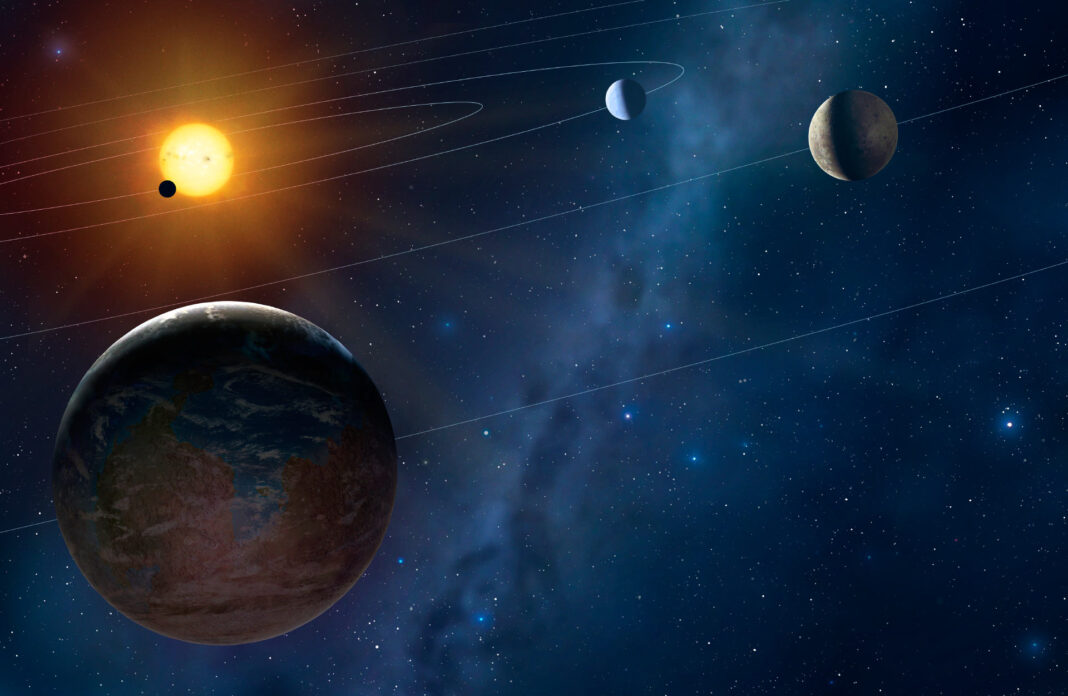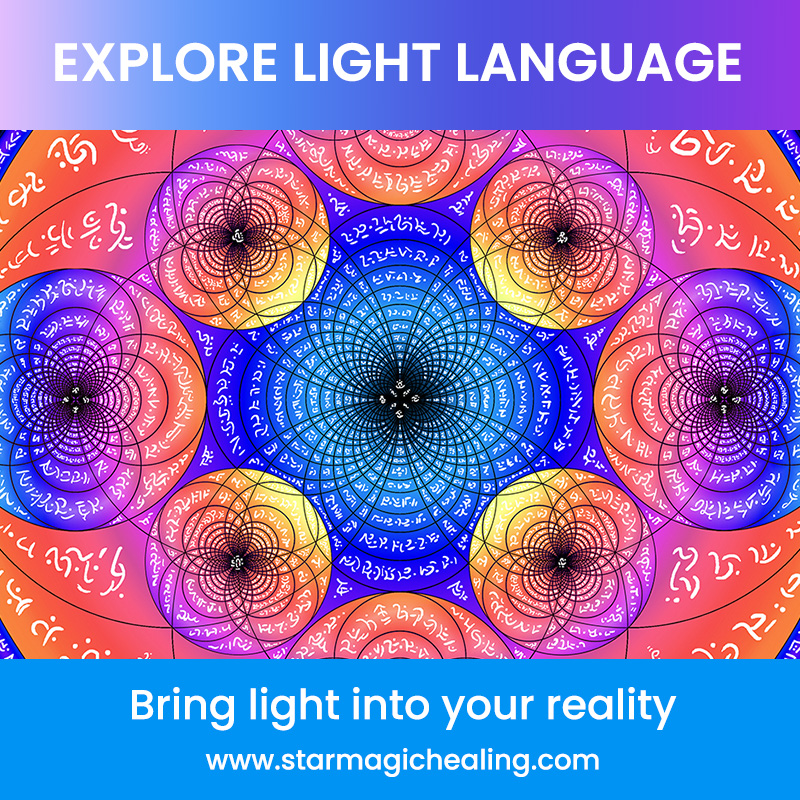We have discovered many extraterrestrial worlds that may be suitable for advanced life with our scientific instruments. With the James Webb Space Telescope (JWST) it will only be a matter of time before we discover earth-like extra-terrestrial worlds.
Continue reading to discover more about how the James Webb Space Telescope is revolutionising our search for extra-terrestrial worlds and learn about some of the possible Earth-like planets that are in our local galactic neighbourhood.
Using the JWST to Find Extra-terrestrial Worlds
It appears that planetary systems around other stars are very common in our Milky Way galaxy. Astronomers have discovered over 800 planets which orbit stars beyond the sun. There may be more planets in our Milky Way galaxy than stars. It is also likely that a small percentage of them may be habitable for humans and for extra-terrestrials.
Our sensitive instruments on Earth and in space are finding planets around most of the stars studied. The Milky Way must have many habitable Earth-sized planets. Planets are everywhere and there are three promising systems in our local galactic neighbourhood. These are in the TRAPPIST-1, Proxima B, and Tau Ceti stellar planetary systems. One day we may visit and explore these ancient worlds and learn from their ancient knowledge and wisdom. We may even find traces of ancient astronaut activity or even meet extraterrestrials face to face.
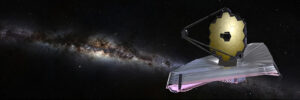
The James Webb Space Telescope will employ advanced technology to pry into the atmospheres of extra-terrestrial worlds. JWST observations will shed spectra of light on our modern and ancient knowledge of extraterrestrial worlds. With the extraterrestrial light and information gathered, visionary scientists will use data analysis and atmospheric modelling to inform and help them to engineer future observations and missions.
A terrestrial world is a planet which has a rocky composition with an atmosphere and ocean making up a small percentage of the planetary mass. Not all terrestrial exoplanets are habitable, and many may resemble Mars or Venus more than the Earth. Many of these worlds may be lava planets too close to their star, mini-Neptune worlds with more gas than rock, or water worlds with little or no land. The JWST will be able to detect the spectra of carbon dioxide, oxygen, water, and some organic molecules.
The James Webb Space Telescope is used by astronomers to monitor stars and galaxies for periods of hours or days. The JWST operates across a large range of infrared wavelengths to detect the frequencies and codes of extraterrestrial light and information. The JWST is state of the art modern technology that is a quantum leap for our understanding of ancient alien worlds and possibly ancient and current life.
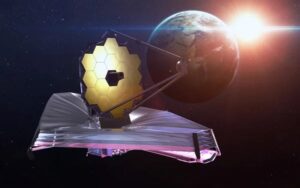
Transit spectroscopy is the method scientists used to calculate whether extraterrestrial planets contain atmospheres. It works by collecting the stellar light and information which passes around a nearby planet and splitting this light into an electromagnetic spectrum. This is like how a prism separates white light into a rainbow of colours and frequencies.
Extra-terrestrial Worlds around TRAPPIST-1
TRAPPIST-1 is a cool red dwarf star that lies in the constellation of Aquarius which has interested astronomers since its discovery in 2017. There is a planetary system of seven known planets orbiting it. TRAPPIST-1 has a mass about 9% of the Sun’s mass and a radius which is slightly larger than the planet Jupiter. The star is about 7.6 billion years old, and it is around 40 light-years distant from the Sun.
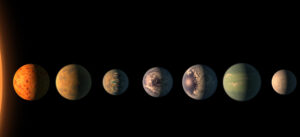
TRAPPIST-1 was found to have at least seven smaller rocky planets. These are extra-terrestrial worlds which orbit their parent star with similar masses and sizes like the Earth. Four of these extra-terrestrial planets have orbits which are within the habitable zone of the star. So, there is a good chance that one or more of these planets will have temperatures where water can be liquid and may possibly host complex life like on Earth.
However, red dwarf stars like TRAPPIST-1 can be volatile and emit a lot of radiation. As a result, it may be tricky for smaller Earth-sized planets to maintain an atmosphere and a magnetic field strong enough to protect it from the stellar wind. So it may be that only large iron rich worlds or giant planets with a powerful magnetic field could afford enough protection for life to begin and evolve without being irradiated.
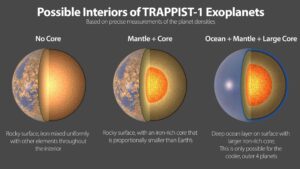
Astronomers will analyse the light spectra collected by the sensitive instruments of the James Webb Space Telescope to determine whether any of the extra-terrestrial worlds orbiting the star possess an atmosphere. The spectrometer on the JWST will also be able to detect certain chemicals that may indicate life on these worlds. If sunlight passes rapidly through a planet’s atmosphere, then we can see the light spectrum of the star. In the spectrum are the chemical signatures of the components of the planet. The imprints of chemical signatures of the atmosphere will be reflected in the light and information of the spectroscopic data collected by the JWST.
Alpha Centauri & Proxima B
Alpha Centauri has three stars. It is also the third-brightest star in our night sky in the Earth’s southern hemisphere. Alpha Centauri is a double star containing Alpha Centauri A and Alpha Centauri B. The two stars orbit each other every 80 years whilst Proxima Centauri orbits at a greater distance. Proxima Centauri is the closest star to the Earth other than the sun. Proxima Centauri is a red-dwarf star which is dimmer than yellow stars like our Sun. It takes half a million years for Proxima to orbit the Alpha Centauri A and B.
Until the year 2035, Alpha Centauri A and B are far enough apart from each other for modern intelligent telescopes to run computer code to discover and analyse the light spectra of orbiting planets. Knowing the chemical composition of the stars in Alpha Centauri, helps astronomers to determine the chemical composition of any orbiting planets from their light spectra.
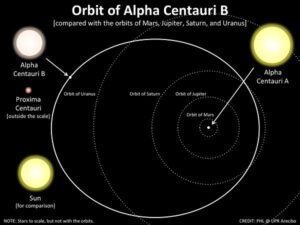
No one from the Earth has directly seen the three distant planets which orbit Proxima Centauri. The planet that is inside the Goldilocks Zone is Proxima b. It is approximately 4.2 light years away from Earth. Proxima b is tidally locked to its star. This means that one face is always facing Proxima Centauri. It rotates around the parent star every 11.2 years and is very close to its star to be in its habitable zone.
We already know a little about Proxima b from our current knowledge and information and from scientific modelling. Proxima b is likely to be geochemically like our Earth. Also, the capacity for water storage in its rocky interior would be about the same as Earth. However, Proxima b would have a slightly larger iron core, and it would be less geologically active with a possible lack of plate tectonics. Its ancient early atmosphere may have been dominated by carbon dioxide, methane, and water. This is like the ancient atmosphere of the Earth between four and two and a half billion years ago.
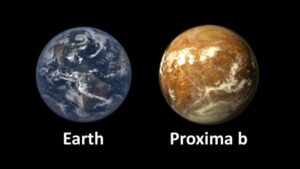
Water may exist on Proxima b, and it is likely that the planet has an atmosphere which may protect it from the extremes of heat and cold. If a rocky planet has an atmosphere, it will absorb visible light from its star and re-emit it as infrared light. The JWST can detect the extraterrestrial light from ancient worlds such as Proxima B with its sensitive spectrometers.
The James Webb Space Telescope is primarily designed to observe infrared light. The JWST can take photos of infrared light on the surface Proxima b by looking for patterns that would confirm whether this exoplanet has water or is covered by an atmosphere. It is also very possible that Proxima b could be more like Venus, with extremes of heat and pressure and be completely barren.
Tau Ceti
Tau Ceti is a single star in the constellation Cetus. Its spectral light is like the Sun despite having about 78% of the Sun’s mass. Tau Ceti is only 12 light years from our Solar System, and it is visible to the naked eye. It is also the closest single G-class star to the sun. This means that Tau Ceti is the closest star that is most like the sun, and it is our best target in the search for habitable Earth-like extraterrestrial worlds.
Stars like our sun may allow ancient extraterrestrial worlds to evolve into earth-like planets capable of hosting intelligent advanced extraterrestrial life. Tau Ceti is a G type star like the sun, and both stars are similar in brightness and volume. So, there is a good chance of life existing on any Earth sized worlds that orbit Tau Ceti in the goldilocks zone.
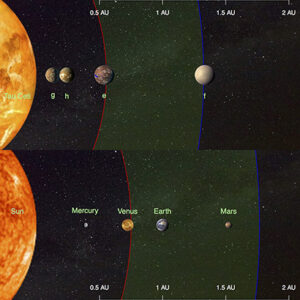
Astronomers believe that there may be four Earth-sized planets orbiting Tau Ceti. The planets were detected by observing the wobbles in Tau Ceti’s motion as small as 30 centimetres per second. These planets range from about one and a half Earth masses upwards which makes them prime candidates for life. Two of the planets are super-Earths or mini-Neptunes which are in the habitable zone of the star. This means that they may support liquid surface water and possibly life. These extra-terrestrial worlds are only twelve light years away and there are between two and six times larger than the earth.
The extraterrestrial worlds orbiting Tau Ceti are not tidally locked in the habitable zone. This is also the case the sun but not with the Proxima Centauri or TRAPPIST-1 stellar systems. This means that two of the planets orbiting Tau Ceti may have seasons and weather in a temperature range where liquid water could exist on the surface like on Earth.
There are many other extra-terrestrial worlds which appear like Earth on paper but are either too far or too near their star, or their star is too large for easy study. Some of these extra-terrestrial worlds may also reveal their secrets to the James Webb Space Telescope in the future. For now, the most promising is Tau Ceti for discovering extraterrestrial life, but all triple star systems are well worth visiting for the ancient knowledge they contain.
Find out more about extra-terrestrials and life other worlds with the transforming Star Magic meditation library and begin your energy healing journey and meet your extraterrestrial brothers and sisters.
Accelerate your journey and ascension deep in space with Infinity which is free for 7 days. This is your cosmic flight plan and ancient mystery school full of guided meditations, spiritual workshops, extra-terrestrial light language activations, and so much more.
